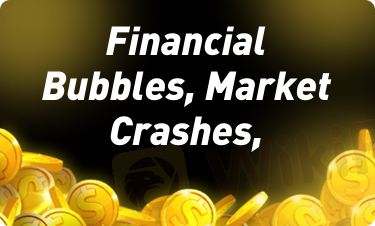
2025-02-17 18:19
ОтраслевойFinancial Market Bubbles and Crashes
#firstdealofthenewyearastylz
Financial Market Bubbles and Crashes
A financial market bubble occurs when asset prices rise significantly above their intrinsic value due to excessive speculation, investor overconfidence, and herd behavior. Eventually, when the overvaluation is no longer sustainable, the bubble bursts, leading to a market crash—a rapid and often severe decline in asset prices.
Causes of Financial Bubbles
1. Excess Liquidity – Low interest rates and easy access to credit can inflate asset prices.
2. Speculation & Herd Mentality – Investors buy assets purely based on rising prices, not fundamentals.
3. Overconfidence & Irrational Exuberance – Investors ignore risks and believe prices will keep rising.
4. Leverage & Margin Trading – Borrowing money to invest amplifies gains but also magnifies losses.
5. Technological or Economic Innovations – New industries (e.g., dot-com boom) attract speculative investments.
Notable Financial Bubbles in History
1. Tulip Mania (1630s, Netherlands) – Tulip bulbs were traded at absurd prices before crashing.
2. South Sea Bubble (1720, UK) – Stock prices of the South Sea Company surged due to speculation and collapsed.
3. 1929 Stock Market Crash – Excessive speculation in stocks led to the Great Depression.
4. Dot-Com Bubble (1999-2000) – Internet company stocks soared irrationally before collapsing.
5. 2008 Financial Crisis – A housing bubble fueled by subprime mortgages burst, leading to a global recession.
Market Crashes: Causes & Effects
A market crash is triggered when investor confidence collapses, leading to panic selling. This can result from:
Economic shocks (e.g., financial crises, wars, pandemics)
Policy changes (e.g., interest rate hikes)
Corporate failures (e.g., Lehman Brothers in 2008)
Effects of a Market Crash:
Wealth Destruction – Investors and businesses lose significant value.
Bank Failures – If financial institutions are exposed, they may collapse.
Unemployment – Economic downturns often follow, leading to job losses.
Government Interventions – Bailouts, stimulus packages, and policy changes may be necessary.
Lessons from Market Bubbles & Crashes
Diversification reduces risk.
Avoid speculation and excessive leverage.
Understand fundamental value rather than following hype.
Monitor interest rates and economic indicators.
Be prepared for market corrections; they are inevitable.
Нравится 0

Ojomary
Брокеры
Популярные обсуждения
Технический показатель
Розыгрыш Xiaomi Redmi Note 9 и 20-и VIP-подписок
Технический показатель
ВЫСКАЗЫВАНИЯ БАЙДЕНА ДАВЯТ НА ВАЛЮТЫ РАЗВИВАЮЩИХСЯ СТРАН
Технический показатель
Европа заключила совместный контракт на поставку ремдесивира для лечения COVID-19...
Технический показатель
Индия: Решение Резерв. Банка Индии по проц. ставке, 4%, ожидалось 4%...
Анализ котировок
Китай: Индекс деловой актив. в сф. услуг Caixin PMI, Сентябрь, 54,8 п.
Технический показатель
События предстоящего дня: "АЛРОСА" опубликует результаты продаж за сентябрь...
Классификация рынка

Платфоома

Выставка

Агент

Вакансии

EA

Отраслевой

Котировки

Показатель
Financial Market Bubbles and Crashes
 Гонконг | 2025-02-17 18:19
Гонконг | 2025-02-17 18:19#firstdealofthenewyearastylz
Financial Market Bubbles and Crashes
A financial market bubble occurs when asset prices rise significantly above their intrinsic value due to excessive speculation, investor overconfidence, and herd behavior. Eventually, when the overvaluation is no longer sustainable, the bubble bursts, leading to a market crash—a rapid and often severe decline in asset prices.
Causes of Financial Bubbles
1. Excess Liquidity – Low interest rates and easy access to credit can inflate asset prices.
2. Speculation & Herd Mentality – Investors buy assets purely based on rising prices, not fundamentals.
3. Overconfidence & Irrational Exuberance – Investors ignore risks and believe prices will keep rising.
4. Leverage & Margin Trading – Borrowing money to invest amplifies gains but also magnifies losses.
5. Technological or Economic Innovations – New industries (e.g., dot-com boom) attract speculative investments.
Notable Financial Bubbles in History
1. Tulip Mania (1630s, Netherlands) – Tulip bulbs were traded at absurd prices before crashing.
2. South Sea Bubble (1720, UK) – Stock prices of the South Sea Company surged due to speculation and collapsed.
3. 1929 Stock Market Crash – Excessive speculation in stocks led to the Great Depression.
4. Dot-Com Bubble (1999-2000) – Internet company stocks soared irrationally before collapsing.
5. 2008 Financial Crisis – A housing bubble fueled by subprime mortgages burst, leading to a global recession.
Market Crashes: Causes & Effects
A market crash is triggered when investor confidence collapses, leading to panic selling. This can result from:
Economic shocks (e.g., financial crises, wars, pandemics)
Policy changes (e.g., interest rate hikes)
Corporate failures (e.g., Lehman Brothers in 2008)
Effects of a Market Crash:
Wealth Destruction – Investors and businesses lose significant value.
Bank Failures – If financial institutions are exposed, they may collapse.
Unemployment – Economic downturns often follow, leading to job losses.
Government Interventions – Bailouts, stimulus packages, and policy changes may be necessary.
Lessons from Market Bubbles & Crashes
Diversification reduces risk.
Avoid speculation and excessive leverage.
Understand fundamental value rather than following hype.
Monitor interest rates and economic indicators.
Be prepared for market corrections; they are inevitable.
Нравится 0
Я тоже хочу высказать замечания.
Задать вопрос
0Комментарии

Пока нет комментариев, оставьте комментарий первым

Задать вопрос
Пока нет комментариев, оставьте комментарий первым